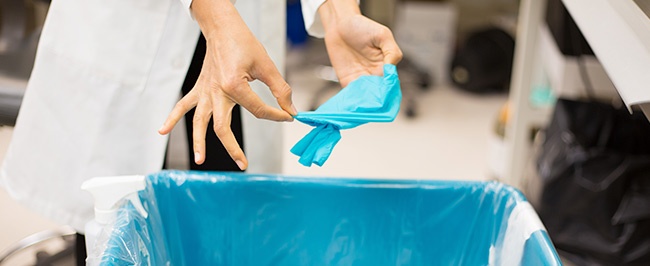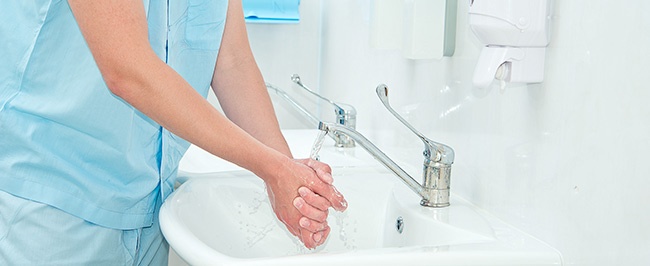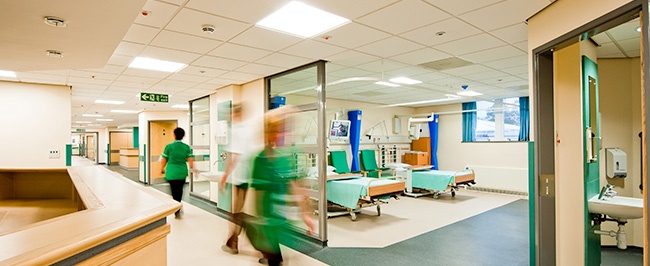

According to the Centers for Disease Control (CDC), on any given day in the U.S., one in 25 hospital patients has at least one hospital-acquired infection (HAI).
There is not a single healthcare facility that does not take this issue seriously and, as a result, infections have decreased markedly since 2006. With the implementation of effective infection control policies, there has been a 25% to 50% decrease in some of the most common types of HAIs (Central Line-Associated Bloodstream Infection, Catheter-associated Urinary Tract Infection, and Surgical Site Infections) (CDC).
Still, with 75,000 patients in the United States having died from HAIs as recently as 2015, there is more infection control work in hospitals to be done. (CDC)
The most prevalent HAIs are pneumonia and gastrointestinal illness, more than half of which occur outside of the highly-protected intensive care unit. In addition to the extreme emotional and physical costs HAIs have on patients and their families, there is a significant economic cost associated with HAIs as well.
According to the World Health Organization (WHO), annual financial losses due to healthcare-associated infections are estimated at approximately €7 billion in Europe (including direct costs only and reflecting 16 million extra days of hospital stay) and at about US$ 6.5 billion in the United States. (WHO)
Infection control and disease prevention are necessary for the sake of patients as well as facilities, and it is critical that all healthcare facility staff are well-versed in the importance of infection control and the protocol required to keep patients safe.
While the CDC, WHO, and other healthcare organizations put out thorough infection control guidelines and infection control training, it is important that you have an understanding of the basic tenets of this critical part of patient care and how it relates to facilities management. Following, you will find an overview of the most important infection control principles as well as links to more extensive reading on each issue.

According to the CDC, infection control “prevents or stops the spread of infections in healthcare settings.” A healthcare provider’s infection control practices can range from the way in which patient rooms are cleaned to the frequency of hand washing by personnel.
It should come as no surprise that proper infection control is the most effective way to stem the spread and impact of hospital-acquired infections, no matter what the sources of infection may be.
An infection control protocol is essential for any healthcare facility, including acute care settings, ambulatory clinics, and long-term care facilities. While each facility may have particular practices that they enact in different ways and may have different approaches in how they communicate their methodologies, the basics of good infection control remain the same. Following are the most critical steps for proper infection control, according to the CDC.

Unsurprisingly, patient care is an essential area of focus for infection control practices. When clinicians and staff interact with patients, visitors, and each other, they must always be aware of the possibility of transferring potentially infectious pathogens.
Regular hand washing is certainly not the most glamorous or thrilling part of working in healthcare, but it is among the most effective healthcare infection control best practices. Hand washing is one of the best ways to prevent HAIs, as well as create a safer, cleaner healthcare environment. Washing your hands is such a commonplace act that it can often feel insignificant, making it easy to overlook the importance of hand washing in infection control.
While understanding the efficacy of different hand cleaning methods (e.g alcohol-based solutions vs. soap and water) is important, the most important factor is that healthcare workers should clean their hands whenever necessary. Because of this, most hospitals will want to have both dedicated hand washing and hand disinfection facilities easily available so that workers (as well as patients and visitors) can easily access them and practice good hand hygiene.
Further Reading: CDC Guideline for Hand Hygiene in Health-Care Settings
While the reduction of HAIs is the goal of infection control, that does not mean that it is only necessary to prevent infection transmission from health care workers to patients. Rather, because health care workers move frequently between patients, it is essential that they protect themselves from potential sources of infection so that they do not transmit those infections to another patient (and so that they themselves do not become ill.) As such, personal protective equipment (PPE) is another one of the essential healthcare hygiene best practices.
Some common forms of PPE are:
Ensure that staff are aware of the proper protocols for disposing of single-use PPE, as well as making disposal convenient so it isn't overlooked.
It is also important to note that certain infectious diseases, such as HIV and Ebola, have specific recommended precautions when it comes to PPE, as well as other infection control procedures. Disease-specific recommendations are available in the CDC Guidelines Directory.
Further Reading: Protecting Healthcare Personnel
Respiratory hygiene is another infection control action that is easy to implement and highly effective in preventing the transmission of infections. Healthcare hygiene best practices indicate that patients, health care workers, and visitors should:
Respiratory hygiene should be strongly encouraged in patient waiting areas where those with respiratory illnesses or weak respiratory systems are likely to come into contact with other patients. Proper practices can be encouraged through the use of signage and the provision of masks to contain secreted droplets, particularly during times of increased respiratory infection (e.g., cold and flu season).
Further Reading: Respiratory Hygiene & Cough Etiquette
According to the World Health Organization, one of the top 4 reasons that patients can acquire an infection in a healthcare setting is the “insufficient application of standard and isolation precautions” (WHO). Patient placement quite basically refers to the place where a patient is placed for the duration of their stay in a healthcare facility.
Patients who are known to be at risk for transmitting infections to other patients and staff should be placed in their own room whenever possible, with access to private hand-washing and toilet facilities. Where not possible, patients infected with the same organisms may be placed together or “
In more extreme cases, a private room is not enough precaution and proper air handling methods must be used. For instance, an isolated patient should be in a room with ventilation that allows for regular air changes. An anteroom setup can also be useful in the case of highly infectious diseases because it allows HCWs who are moving in and out of the room to avoid transmitting dangerous airborne particles from the sources of infection when they enter a non-isolated area.
The setup for any isolated patient will depend on whether the patient themselves is infectious or whether they are immunocompromised and additional precautions must be taken to protect them from HAIs.
Further Reading: Guideline for Isolation Precautions: Preventing Transmission of Infectious Agents in Healthcare Settings
There are different ways that a patient can acquire an infection in a healthcare facility, including transmission from another patient or from a HCW. Additionally, the equipment and environment that a patient comes into contact with can be a hotbed of infectious possibilities if it is not properly cleaned and disinfected.
The right way to disinfect patient care equipment depends heavily on what type of equipment it is. The standard for most healthcare facilities is based on the idea of critical, semicritical, and noncritical items. As one would expect, critical items include all surgical instruments that enter sterile tissue or the vascular system. Semicritical items are those that come into contact with mucous membranes or nonintact skin, and noncritical items can be either patient care equipment or environmental surfaces that come into contact with intact skin.
Critical items should be purchased sterile and sterilized with steam when necessary. Other items should be disinfected with the chemicals that have been identified to work best with that particular item, paying attention to the longevity of the material where necessary. UV disinfection can be appropriate in some cases.
[See also: Environmental Infection Control]
There is no single "correct" environment for patient care, and just as the environments themselves should be tailored to the type of care taking place within them, cleaning and disinfection protocols need to adapt to the environment and patient.
In general, air pressure should be monitored daily: negative pressure for airborne infection isolation rooms (AII) and positive pressure for protective environment rooms (PE). The aforementioned practice of air cycling is essential in maintaining sterile environments, both inside the environment and in the surrounding areas, and technologies such as far ultraviolet, or far-UV, can be used to disinfect patient care environments.
[See also: Environmental Infection Control]
Patient injections, when not performed correctly, have the potential to be extremely hazardous in terms of the spread of infection. Luckily, safe injection practices are a key component of virtually every healthcare facility’s infection control procedures, including:
Further reading: Make Smart Injection Choices: Safe Injection Practices

While patient care is, of course, critical in maintaining proper infection control protocol in a healthcare facility, environmental infection control is just as important. The environment that houses patients is, in most cases, the same place where those patients receive care from workers and
In addition, when one patient is discharged from a facility or moved to another room, that same environment then houses another patient, often in the same day. It is essential that all parts of the healthcare environment, from the patient care rooms to the waiting area, be maintained at a certain level of cleanliness in order to optimize infection control. It is environmental infection control where facilities managers and their staff can play the largest role.
Further reading: CDC Guidelines for Environmental Infection Control in Healthcare Facilities
Airborne pathogens can be some of the most difficult to protect against in the healthcare environment. Not only can pathogens be transmitted from patients and HCWs, but they can also come into the facility through open windows, doors, and regular circulation.
The heating, ventilation
Patients who meet certain criteria must be placed in rooms that are designed for maximum isolation. To ensure
While the pathogens that are transmitted by human beings can often be the focus of infection control protocol, maintenance and construction procedures can represent a significant risk to patients as well as healthcare workers. When work is done in any part of a healthcare facility that may disrupt dust and pathogens, including above-ceiling maintenance, it is critical that facilities utilize effective dust control procedures. In many cases, portable dust containment units may be the most practical solution for this.
As noted above, hand hygiene is perhaps
Further, regular tests should be performed to ensure that the water coming into the facility is clean and free from harmful pathogens. Standing water can present a hazard, including infrequently used water tanks, so care must be shown to regularly maintain and disinfect all water supplies.
[See: Patient Care Infection Control Guidelines]
The patient care environment consists of noncritical items -- meaning environmental items that only come into contact with intact skin, a natural barrier to infectious microorganisms. Examples of noncritical environmental items include walls and floors, bedpans, computers, crutches, and blood pressure cuffs.
Noncritical environmental items should be cleaned at regular intervals with low-level disinfectants. Of note is the fact that mops and mop water, when not laundered and changed regularly, can contribute to the spread of diseases, even though they themselves are noncritical, so it is important to put in place protocols that prevent this type of lapse.
All textiles in a healthcare facility must be regularly and properly laundered for infection control and general hygienic purposes. Personal protective equipment worn by healthcare workers or facility visitors must be regularly laundered at the facility, as well as curtains, bedding, and other soft surfaces that could harbor pathogens. A laundry facility that is equipped with handwashing capabilities and has been built in accordance with AIA construction standards is essential.

The above guidelines for infection control in healthcare facilities are barely the tip of the iceberg. Organizations such as the CDC, WHO, and AIA are able to offer much more thorough procedures for a comprehensive infection control program.
Utilizing infection control methods that are tested and proven is essential to the effectiveness of any hospital. Keep patients safe is, of course, the top priority, but in addition, HAIs can represent a significant cost to healthcare facilities. In fact, according to one study, HAIs can cost U.S. hospitals up to $45 billion per year.
This same analysis found that effective infection control could prevent up to $31 billion of these costs. Further, research shows that when healthcare facilities and their staff are aware of infection problems and take specific steps to prevent them, rates of some HAIs can decrease by more than 70 percent.
The ethical need for infection control is clear. Coupled with the actual costs to healthcare facilities and companies, the importance of infection control cannot be overstated.
Ultimately, it is the job of every healthcare facility employee to learn and practice good infection control policies. However, establishing an infection control team that acts as the ambassadors for policies, protocol and any changes that need to occur can be extremely effective.
An infection control team should consist of at least one clinical champion and one person from the facilities team who knows the intricacies of the facility cleaning and maintenance processes. Others may be added to the team for special projects as well, particularly major construction and renovation projects.
Members of the infection control team should be well-versed in infection control and open to or actively pursuing advanced training in infection control best practices.
The team that takes responsibility for your facility’s infection control policies should be the ones that:

There is no question that infection control is a critical element to the sustained success of any healthcare facility. It is only when the patients are the priority and their safety is the top concern that hospitals and other healthcare facilities are able to grow and thrive.
Unfortunately, there are no quick fixes when it comes to infection control. Rather, diligence and ongoing education are the keys to ensuring patients safety and minimizing the possibility of hospital-acquired infections. Although advanced infection control technologies are making it easier to operate cleanly and safely, there is no substitute for attention to detail and a strong foundation knowledge of infection control principles.
Unit 3
Guardian Point
Guardian St
Warrington
WA5 1SJ